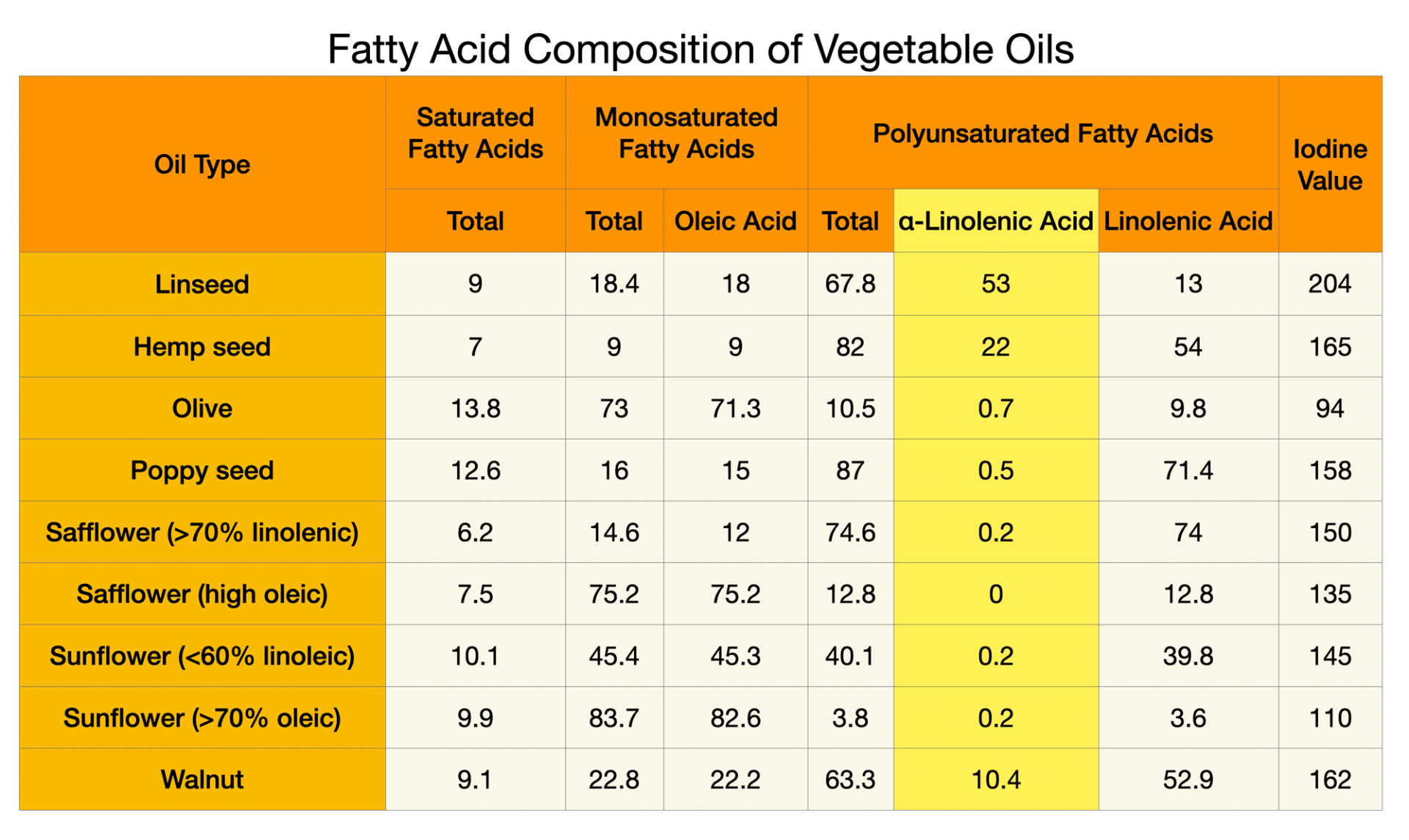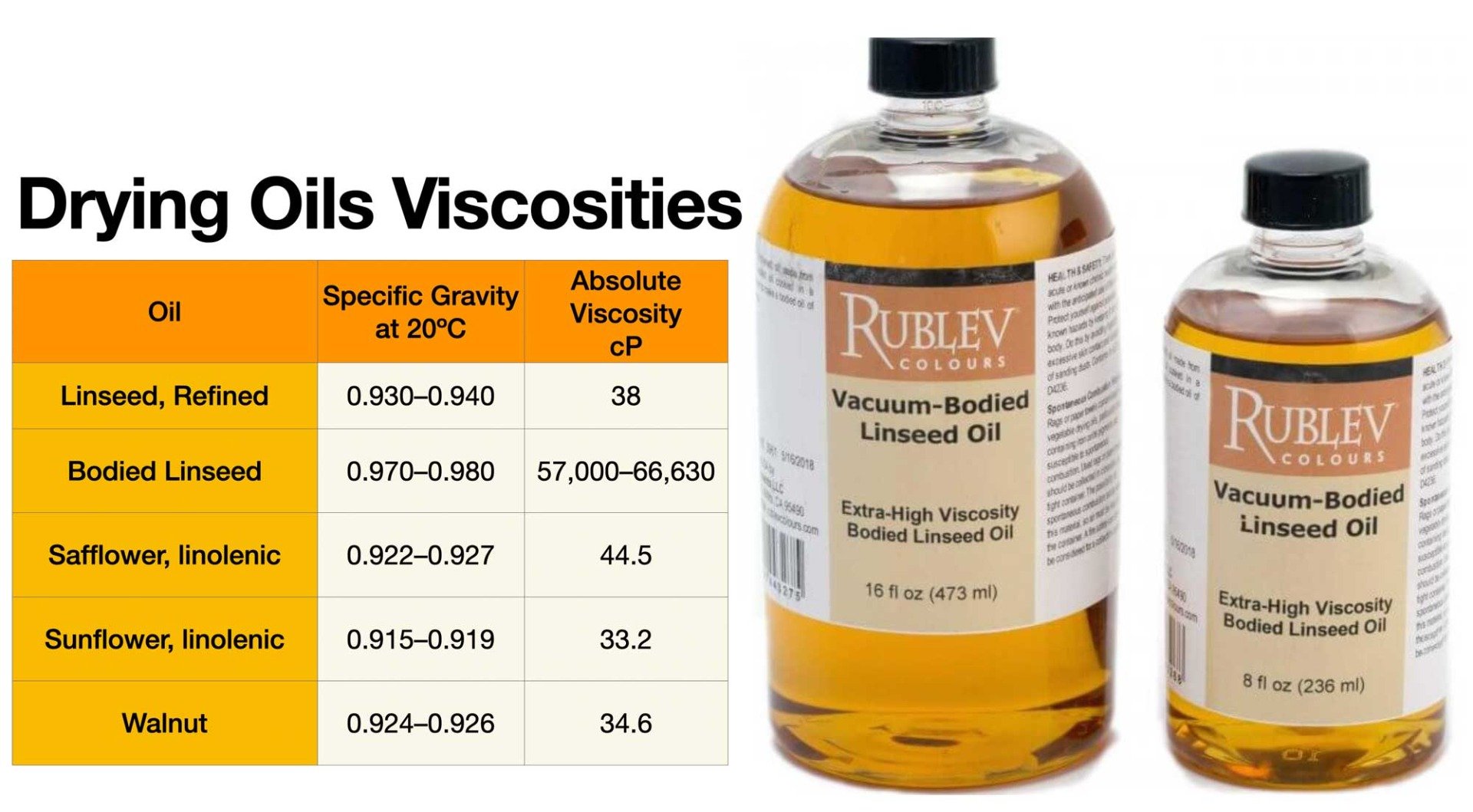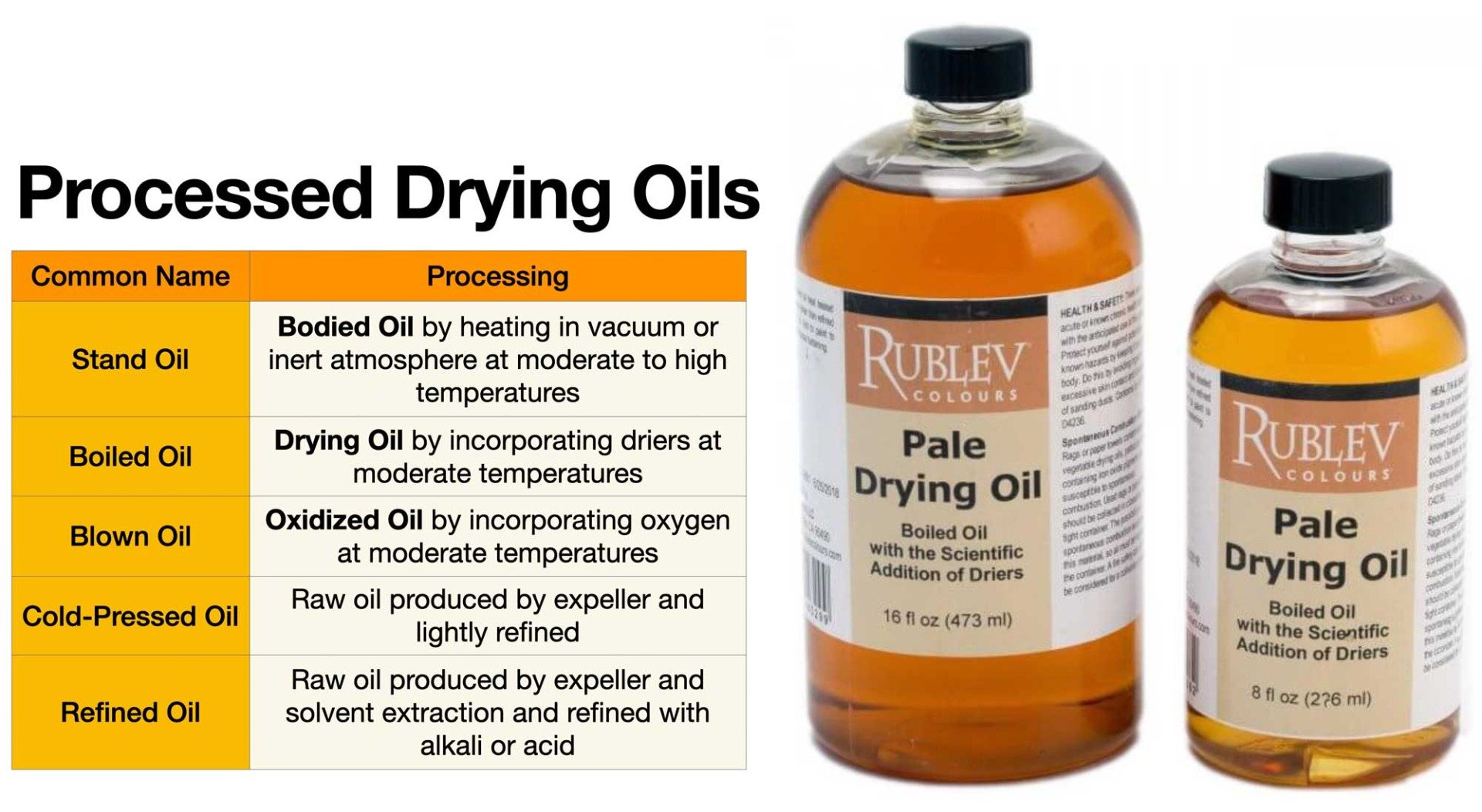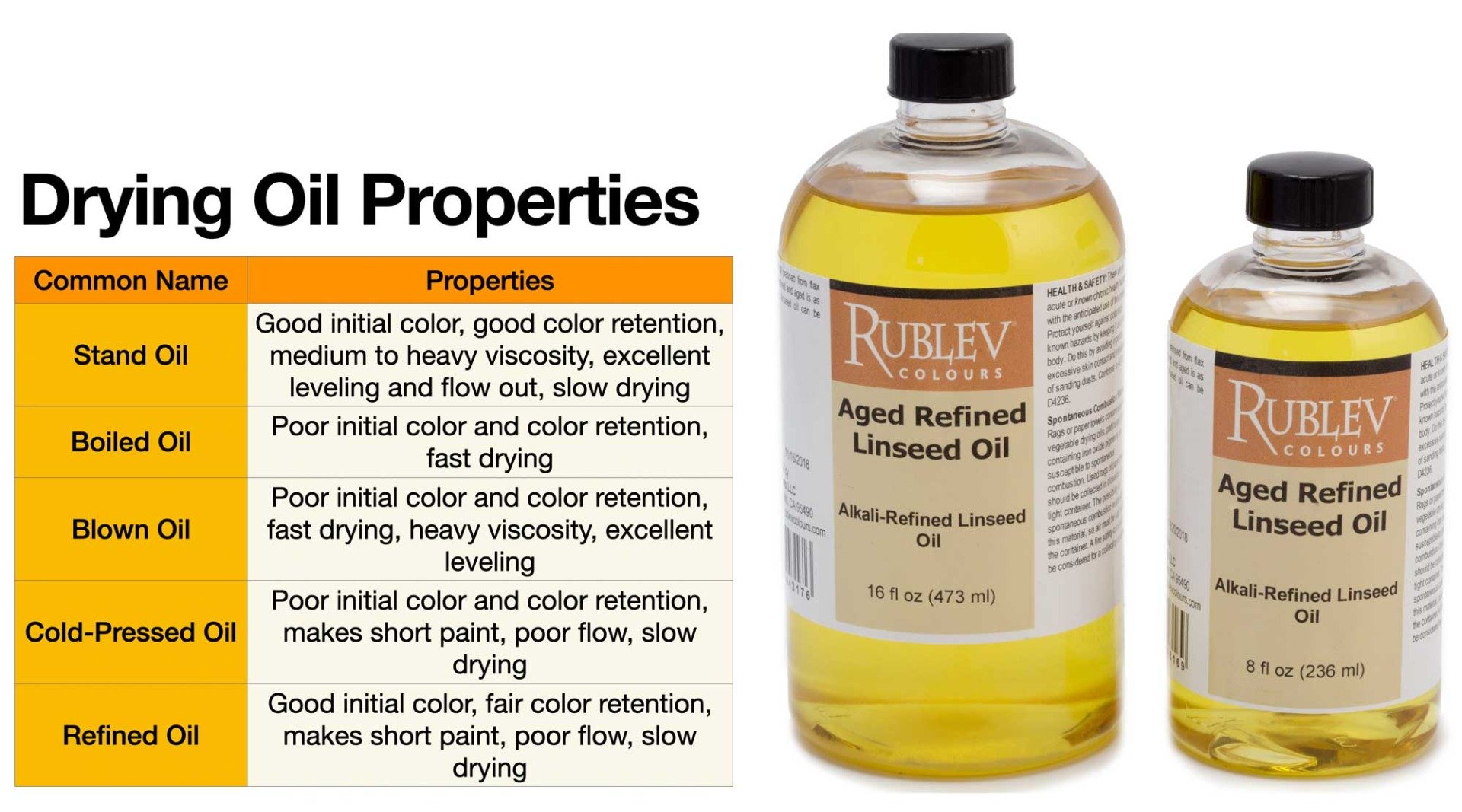Raw oils are unprocessed and extracted from the seed or nut without any refining process. In contrast, refined oils undergo various refining processes to remove impurities and improve their quality.
How to Choose the Right Drying Oil for Your Art

If you’re an oil painter, you know that selecting the right drying oil is critical to achieving a successful finished painting. With so many different types of oils available, choosing the right one can be daunting. In this article, we’ll explore the differences between raw, cold-pressed, alkali-refined, bodied, and drying oils for oil painting. Understanding these differences allows you to select the right oil for your painting project to achieve the desired effects.
Drying oils are oils that solidify into a robust film after being exposed to air at room temperature. Rather than evaporating water or other solvents, the oil undergoes a chemical reaction in which its components crosslink and polymerize due to the action of oxygen. Such oils serve as a vital component in oil paints and some varnishes, with linseed oil, tung oil, poppy seed oil, perilla oil, and walnut oil commonly used for such purposes. However, the use of drying oils has declined for the past few decades, as they have been replaced by other binders such as alkyd resins.
Since oxidation is the key to curing these oils, those oils susceptible to chemical drying are often unsuitable for cooking and highly susceptible to becoming rancid through autoxidation, the process by which fatty foods develop off-flavors. Materials such as rags, cloth, and paper saturated with drying oils can spontaneously combust or ignite after a few hours as heat is released during the oxidation process.
The Drying Process
The process of drying oils involves the hardening of an oil film through a chemical reaction with oxygen. This reaction causes the components to crosslink, resulting in the polymerization of the oil rather than the evaporation of solvents or water. The curing or “drying” process is initiated through autoxidation, which involves the addition of oxygen to an organic compound and subsequent crosslinking. This reaction commences with an oxygen molecule (O2) in the air inserting itself into carbon-hydrogen (C-H) bonds close to one of the double bonds within the unsaturated fatty acid. The resulting hydroperoxides are then susceptible to crosslinking reactions. Bonds form between neighboring fatty acid chains, resulting in a polymer network that is visible through the formation of a skin-like film on samples. This polymerization results in stable films that, while somewhat elastic, do not flow or deform easily. Fatty acid derivatives that contain dienes, such as those derived from linoleic acid, are particularly susceptible to this reaction as they generate pentadienyl radicals. Monounsaturated fatty acids, such as oleic acid, are slower to undergo drying as the radical allylic intermediates are less stable and thus slower to form.
Metal Driers
Certain metal salts, particularly cobalt, manganese, or iron derivatives, accelerate the drying process by functioning as homogeneous catalysts. These coordination complexes are derived from lipophilic carboxylic acids, like naphthenic acids, to make them oil-soluble. These catalysts increase the reduction of the hydroperoxide intermediates, leading to a series of additional reactions and further crosslinking. Polymerization occurs over days to years, rendering the film dry to the touch. However, premature action of the drying agents can cause skinning of the paint, which is prevented by adding anti-skinning agents like methyl ethyl ketone oxime.
Monitoring the drying process is possible by observing the weight changes in an oil film. The film becomes heavier as it absorbs oxygen, increasing the weight by up to 25 percent. After oxygen uptake ceases, the weight of the film declines as volatile compounds evaporate. As the oil ages, many of the original ester bonds undergo hydrolysis, and the mobile phase of the polymer network may play a role in plasticizing paint films. The original network is replaced by an ionomeric structure held together by ionic interactions. The structure of these ionomeric networks, however, is not well understood.
Thermal Polymerization
In the absence of air, most drying oils rapidly increase viscosity after heating. If subjected to raised temperatures for a long time, the oil will become a rubbery, oil-insoluble substance.
Constituents of Drying OIs
In organic chemistry, drying oils are characterized as glycerol triesters of fatty acids, exhibiting high concentrations of polyunsaturated fatty acids, particularly alpha-linolenic acid. The siccative or drying property of oils is commonly evaluated through the iodine number, an index of the number of double bonds present in the oil. According to this scale, oils with an iodine number greater than 130 are classified as drying, those with an iodine number ranging from 115 to 130 are semi-drying, and those with an iodine number less than 115 are non-drying.

In contrast, non-drying waxes, such as hard-film carnauba or paste wax, and resins, such as dammar, copal, and shellac, consist of extended, spaghetti-like chains of hydrocarbon molecules that weave and compact but do not form covalent bonds similar to drying oils. Therefore, waxes and resins can be redissolved, whereas a cured oil varnish or paint cannot be.
Drying Oils for Oil Painting
Vegetable oils are divided into three categories:
- Non-drying oils with an iodine number less than 115; i.e., olive, castor, corn, peanut
- Semi-drying oils with an iodine number 115–130; i.e., soybean, safflower (high oleic), sunflower (high oleic)
- Drying oils with an iodine number greater than 130; i.e., linseed, tung, poppy seed, walnut, safflower (high linolenic), sunflower (high linolenic)
Drying oils are used as the binder to make oil paint and as a medium to mix with paint. The most common drying oils used in oil painting are linseed oil, poppy seed oil, walnut oil, and safflower oil.
Linseed Oil
Linseed oil is one of the most commonly used drying oils in oil painting. It dries to a hard, durable finish and is compatible with most pigments. It can also be used as a medium to thin paint or to create glazes. Linseed oil has a yellowish tint, which can affect the color of the paint over time. In practice, however, this is less concerning in most paint applications, except perhaps when working with brilliant white highlights or pale blue colors in glazes.
Poppy Seed Oil
Poppy seed oil is a pale yellow oil that dries slowly and produces a flexible, durable film. It is often used in the final layers of a painting as it allows for more time to blend and work with the paint. Poppy seed oil is also known for its ability to enhance the brightness of pigments.
Walnut Oil
Walnut oil is a light, pale yellow oil that dries slowly and produces a flexible, durable film. It is often used as a substitute for linseed oil, as the initial yellow is less than linseed oil, and some claim it does not yellow as much over time. Walnut oil is also known for enhancing the flow of paint.
Safflower Oil
Safflower oil is a light, nearly colorless oil that dries the slowest of drying oils used by artists and produces a flexible film. It is often used as a substitute for linseed oil when increased drying time is desired and is believed does not yellow as much over time. Safflower oil is also known for its ability to enhance paint flow and create a matte finish.
Understanding the Different Types of Drying Oils
Before we dive into the specific types of oils, it’s essential to understand the differences between raw oils and refined oils. Raw oils, as the name suggests, are unprocessed and extracted from the seed or nut without any refining process. Refined oils, on the other hand, go through various refining processes to remove impurities and improve their quality.
Raw Oils
Raw oils are extracted directly from the seeds or nuts of the plant without any refining process. They are typically more viscous and have a darker color than other types of oils. Common raw oils include linseed, walnut, and poppy seed oil. Edible oils can be “expeller-pressed” or “cold-pressed,” which refers to the process by which the oil is extracted from the seed or nut. Expeller-pressed oil is extracted from the seed by a press, as described in another article, using heat and pressure. Cold pressed means that the oil is extracted in a press at a temperature of less than 49°C (120°F).
Another typical oilseed extraction process is solvent extraction. Due to low oil recovery, mechanical oil extraction is not widely used in the United States. Small processors prefer using an expeller or screw press because of its low capital cost. Solvent extraction with hexane is the standard practice in today’s modern oilseed-processing facilities. Solvent-extraction plant capacities range from 100 to 9000 metric tons per day. The most common solvent is n-hexane for its attributes, such as simple recovery, non-polar nature, low latent heat of vaporization, and high selectivity to solvents. Solvent extraction increases oil yield from seeds and results in lower-cost oil.
Cold-Pressed Oils
You may have read about the advantages of cold-pressed oils in painting. Many artists believe oil produced at a lower temperature has better properties than hot expeller press oil. This belief originated in artists’ manuals written in the 19th century due to the oils derived from expeller presses. This information was later copied by authors writing texts in the 20th century without investigating changes in the industry. Arthur Herbert Church, the author of The Chemistry of Paints and Painting, wrote in 1892:
Heat and pressure give a more abundant oil yield, but the product is less pure and less well-fitted for use in painting. The bulk of the oils of commerce is thus obtained. Cold-pressed oils remain clear in cold weather, are more fluid than hot-pressed oils, and contain a smaller proportion of solid fats and free fatty acids.
Church describes the difference in properties between cold-pressed and hot-pressed oils.
The cold-pressed oil is very pale straw-coloured, or pale yellow, with occasionally a faint greenish hue; the hot-pressed oil is a darker yellow or brown. The cold-pressed oil, when considerably cooled, remains clear long after the hot-pressed oil has become turbid. The fluidity of the oil is less than that of water in the ratio of 1:10. The hot-pressed oil has a much stronger taste and odour than the cold-pressed oil.
When Church wrote these statements, modern refining methods were unknown or not in widespread use; hence hot expeller-pressed oils contained impurities that affected the color and drying ability of the oil. Cold-pressed oils are extracted using a press that applies minimal heat and pressure to the seeds or nuts, resulting in fewer phospholipids (gums), oxidized products, metal ions (e.g., iron, copper), yellow pigments (e.g., gossypol), and insoluble impurities than oils extracted by heat or solvent. However, when modern refining methods became widespread in the 20th century, hot expeller-pressed and solvent-extracted oils replaced cold-pressing as the primary extraction method. The resulting refined oils contained fewer impurities and better initial color and color retention properties.
Common cold-pressed oils used in oil painting include cold-pressed linseed, walnut, and poppy seed oil. Cold-pressed oils tend to have a thicker consistency and a more intense yellow color than refined oils. They are also more expensive than refined oils due to their lower yield.
Alkali-Refined Oils
Alkali-refined oils are processed using an alkali to remove impurities and reduce the color and viscosity of the oil. These oils are typically less expensive than raw or cold-pressed oils and are commonly used in all grades of oil paints. Some common alkali-refined oils used in oil painting include linseed and safflower oil.

Stand or Bodied Oils
Stand oil is oil that is heat-treated and polymerized to thicken the oil. The term “stand oil” derived from the Dutch word designating drying oil that had been heated and aged by standing in tanks. The term “stand oil” is antiquated since bodied oils today are processed differently than in the 19th century. However, stand oil is still used by authors of artists’ manuals and artists’ materials manufacturers for oils bodied by heating for prolonged periods in open or closed kettles.
Bodied oils are thickened by heating in a vacuum or inert atmosphere, typically nitrogen. Bodied oil is polymerized oil made by heating refined linseed oil at a high temperature of up to 300° C (572° F) for some time. Where color and low acid numbers are essential, it is heated in a vacuum or under a blanket of inert gas. Bodied linseed oil has an acid value in a wide range, depending on whether it is heated in a vacuum, inert atmosphere, or open kettle. Vacuum-bodied oils have better color and the lowest acid numbers than heating oil in an inert atmosphere or open kettle.
Bodied oil leaves an enamel-like or glossy finish to paint. They also increase the leveling and flow out of oil paint and oil painting mediums, reducing the appearance of brushstrokes, improving the blending of colors, and increasing gloss. Bodied oils form harder films than refined or raw linseed oils.
Bodied oil has better color retention than unbodied oil. This can be understood if we consider that bodied oil is partially thickened (similar to a dried film) using thermal polymerization. Such a film dries slower than a similar film of unbodied oil because it absorbs less oxygen, which promotes autoxidation. Since oxidation is mainly responsible for yellowing and a paint film polymerized thermally has oxidized less than unbodied oil paint films, we can understand why it has better color retention.
Adding large amounts of bodied oil may increase the tendency of oil paintings to wrinkle (alligator). Adding as little as 10% by volume of bodied oil to alkyd painting mediums increases the viscosity of the alkyd medium and slows the drying time.
Drying Oils
Drying oils are oils that are heated with catalytic driers, such as manganese. These oils are used to speed up the drying time of the paint and oil painting mediums. These are often called “boiled oils,” usually made using linseed oil.


Choosing the Right Drying Oil for Your Art
Several factors must be considered when choosing a drying oil for your art. Here are some tips to help you choose the correct drying oil for your art:
Consider the Color and Viscosity
The color and viscosity of the oil can significantly affect the final appearance of your artwork. Raw oils and cold-pressed oils are typically more viscous and have a darker color, while refined oils are lighter in color and have a thinner consistency. Consider the effect you want to achieve in your art and choose the oil that best suits your needs.
Consider the Drying Time
The drying time of the oil can also affect your artwork. Drying oils are typically used to speed up the drying time of the paint, but some oils dry faster than others. If you are working on a time-sensitive project, choose an oil that dries quickly, such as linseed oil. If you have more time, you can use a slower-drying oil like walnut oil or poppy oil.
Consider the Longevity
The longevity of your artwork is also important to consider. Alkali-refined oils are considered to be of the most suitable quality for painting and can result in artwork that lasts for many years. Choose a high-quality oil if you want your artwork to stand the test of time.
Experimenting with Different Oils
The best way to find the right drying oil for your art is to experiment with different oils and see which works best. Try mixing different oils with your pigments and see which one gives you the desired result. You may prefer a combination of different oils to achieve the perfect consistency and color. For example, adding bodied oil to refined oil can increase the leveling and flow out of the paint, resulting in better blending and fewer brushstrokes.
Safety
In the process of curing, rags, cloth, and paper that are saturated with drying oils may pose a significant risk of spontaneous combustion due to the heat released. This risk is more prominent when the oil-soaked materials are folded, bunched, or piled together, which leads to the accumulation of heat and an acceleration of the reaction. To mitigate this risk, it is advisable to wet the rags with water and spread them away from direct sunlight or store them in air-tight metal containers that are designed for such applications. One example of a catastrophic incident resulting from the spontaneous combustion of linseed oil-soaked rags occurred in the One Meridian Plaza 38-story office building, where a large fire caused severe structural damage and led to the building's demolition.
It is commonly believed that spontaneous combustion can occur with rags soaked in paint thinners. However, this is untrue unless a drying oil is used as a thinner. Classical paint thinners do not include drying oils, so the risk is mainly associated with rags soaked in oil-based paints. The drying oils in the paints or varnishes, and not the thinners per se, pose a danger, except when the thinners are mixed with drying oils like linseed. Therefore, handling and storing these materials with caution is essential to avoid accidents caused by the risk of spontaneous combustion.
Conclusion
Choosing the right drying oil for your oil painting can make a significant difference in the quality and longevity of your artwork. Consider the different types of oils available, such as raw, cold-pressed, alkali-refined, stand or bodied, and drying oils. When choosing an oil, consider the color and viscosity, the drying time, and the longevity. Experiment with different oils to find the perfect combination for your artwork.
Frequently Asked Questions
What is the difference between raw and refined oils?
What is the most commonly used drying oil in oil painting?
Linseed oil is one of the most commonly used drying oils in oil painting.
What is the difference between cold and expeller-pressed oils?
Cold-pressed oils are extracted without heat, while expeller-pressed oils are extracted using heat.
Can drying oils be used as a medium to mix with paint?
Yes, drying oils can be used as a medium to mix with paint and to increase its drying time.
Are there any health concerns when working with drying oils in oil painting?
The drying oils used in oil painting do not present a health concern unless you have hypersensitivity to certain foods, like a nut allergy.
Can different drying oils be mixed together?
Different drying oils can be mixed together to achieve specific effects, such as enhancing the flow of the paint or increasing the drying time.
Can I use vegetable oils as a substitute for drying oils?
Non-drying vegetable oils, such as olive oil, should not be used as a substitute for drying oils in oil painting, as they do not dry properly and can cause the paint to crack and yellow over time.
How do I properly clean my brushes and tools after working with drying oils?
After working with drying oils, cleaning your brushes and tools with soap and warm water is important. You do not need to use solvents such as mineral spirits or turpentine to clean brushes or surfaces so you can eliminate solvents in oil painting. If you use solvent, work in a well-ventilated area and dispose of the used solvents properly.
Can drying oils be used with water-miscible oil paints and painting mediums?
You can use drying oils with water-miscible oil paints and painting mediums, but you will diminish the water-miscible properties of these products when adding drying oils.
References
Church, Arthur Herbert. The Chemistry of Paints and Painting. United Kingdom: Seeley, 1892. pp. 35, 42.
Poth, Ulrich. (2002). “Drying Oils and Related Products.” Ullmann’s Encyclopedia of Industrial Chemistry. Weinheim: Wiley-VCH. doi:10.1002/14356007.a09_055.
Porter, Ned A.; Caldwell, Sarah E.; Mills, Karen A. (1995). “Mechanisms of free radical oxidation of unsaturated lipids.” Lipids 1995. Vol. 30, pp. 277–290. doi:10.1007/BF02536034
Apps, E. A. (1958). Printing Ink Technology. London: Leonard Hill [Books] Limited. p. 14.
“Autoxidation.” McGraw Hill Encyclopedia. 8th ed. 1997.
Friedman, Ann, et al. (2006). “Painting.” www.worldbookonline.com. 2006. 46 Stetson St. #5 Brookline, MA. 10 May 2006
“History of Oil Paint.” www.cyberlipid.org. 5 May 2006 (Archived 16 September 2009).
van den Berg, Jorit D.J. (2006). “Mobile and Stationary Phases in Traditional Aged Oil Paint.” www.amolf.nl 2002. MOLART. 8 May 2006.
Erhardt, David, Charles S. Tumosa, and Marion F. Mecklenburg. (2005). “Long-Term Chemical and Physical Processes in Oil Paint Films.” Studies in Conservation 50, no. 2 (2005). p. 143–50. http://www.jstor.org/stable/25487732.
Andés, Louis Edgar. (1901). Drying oils, boiled oil, and solid and liquid driers. London: Scott, Greenwood & Co.
Silvia Pizzimenti, Luca Bernazzani, Maria Rosaria Tinè, Valérie Treil, Celia Duce, and Ilaria Bonaduce. (2021). “Oxidation and Cross-Linking in the Curing of Air-Drying Artists’ Oil Paints.” ACS Applied Polymer Materials 2021 3 (4), pp. 1912–1922. DOI: 10.1021/acsapm.0c01441.
Honzíček, jan. (2019). “Curing of Air-Drying Paints: A Critical Review.” Industrial & Engineering Chemistry Research 2019 58 (28). pp. 12485–12505. DOI: 10.1021/acs.iecr.9b02567.
“Oilseed Presses.” PennState Extension. https://extension.psu.edu/oilseed-presses
“Oil and Oilseed Processing III.” Oklahoma State Univerity Extension. https://extension.okstate.edu/fact-sheets/oil-and-oilseed-processing-iii.html
Zeldenrust, Robert S. “Alkali Refining.” AOS Lipid Library. https://lipidlibrary.aocs.org/edible-oil-processing/alkali-refining










